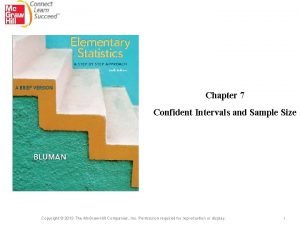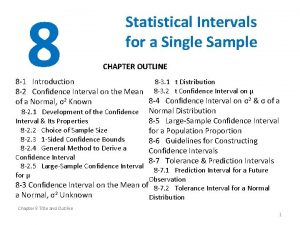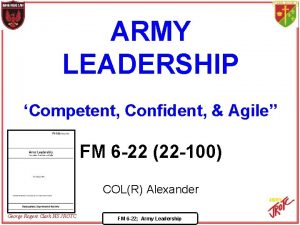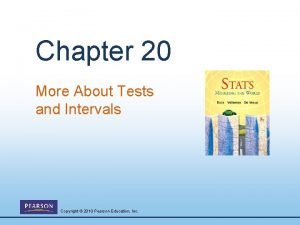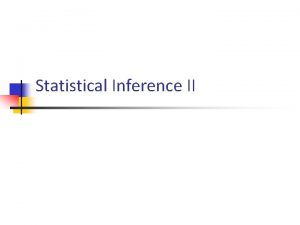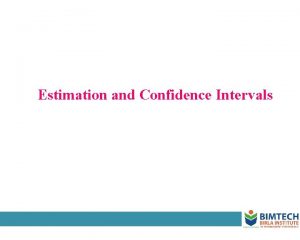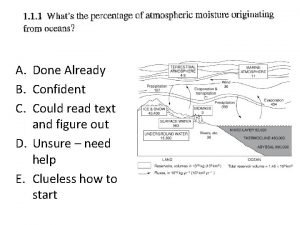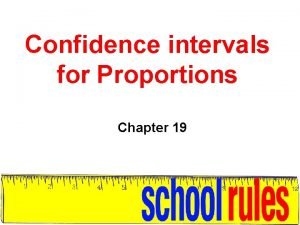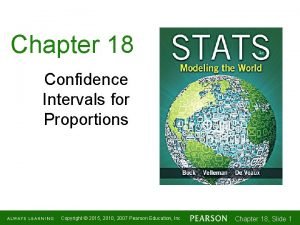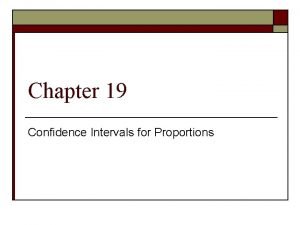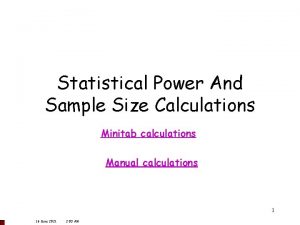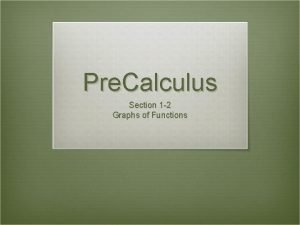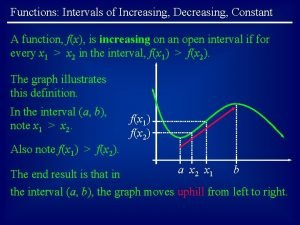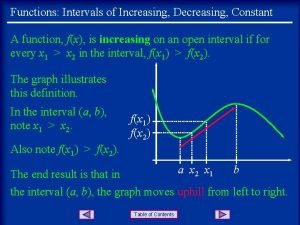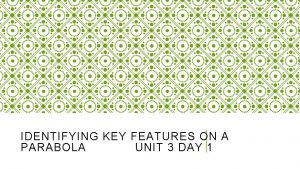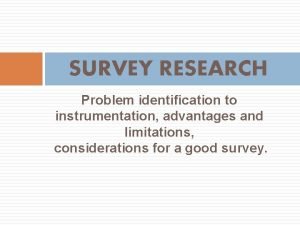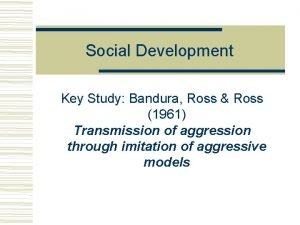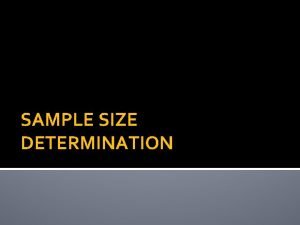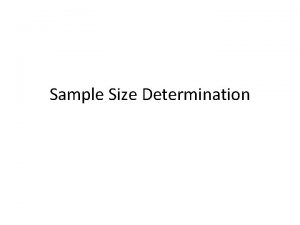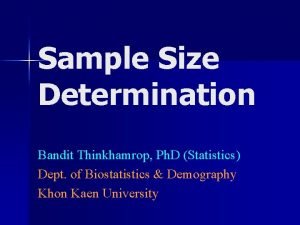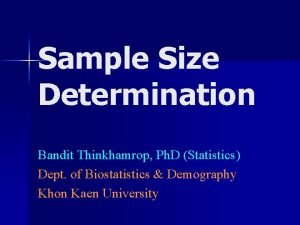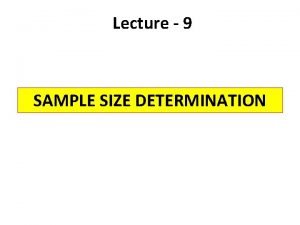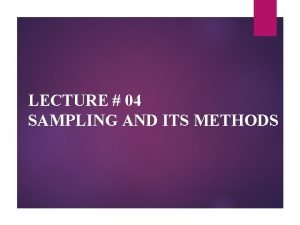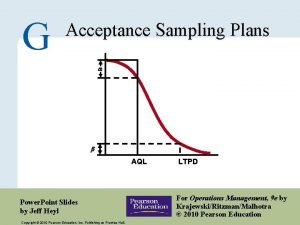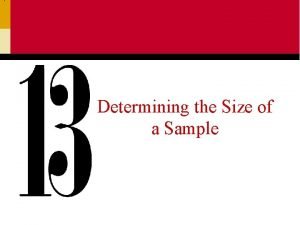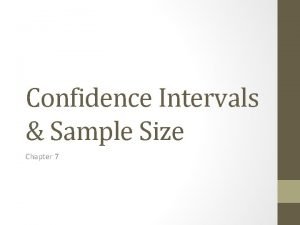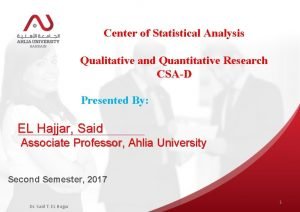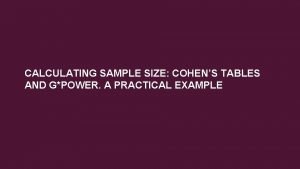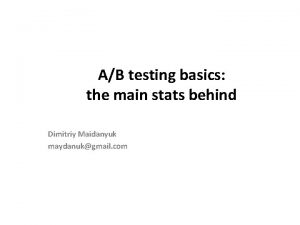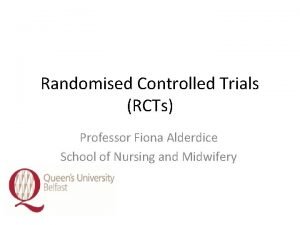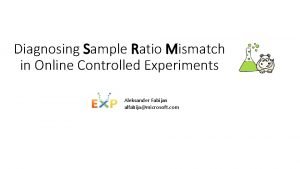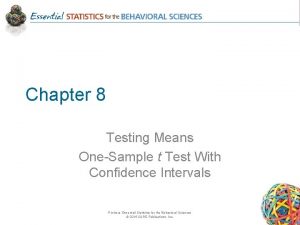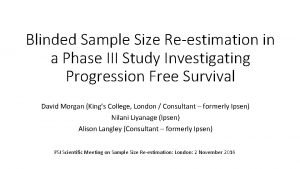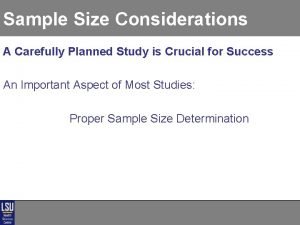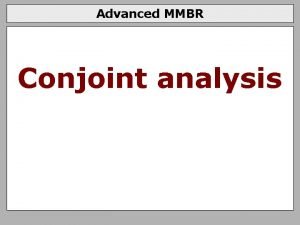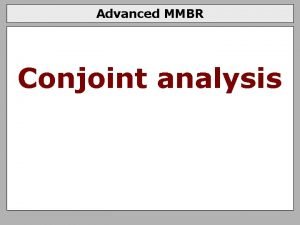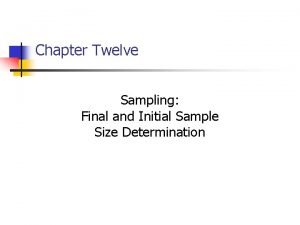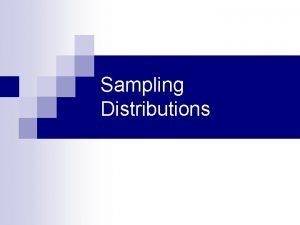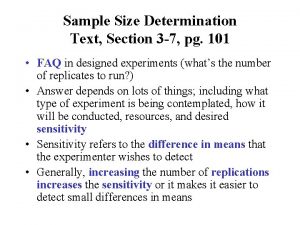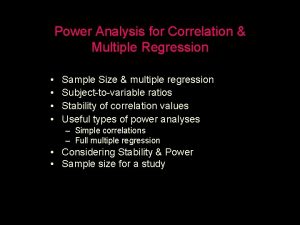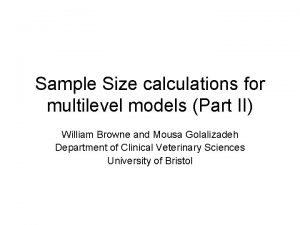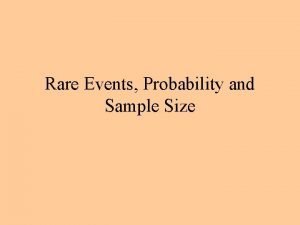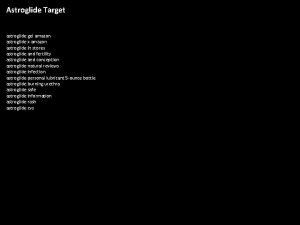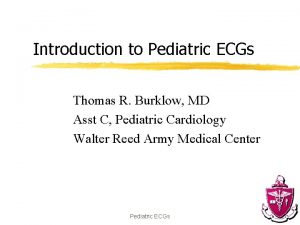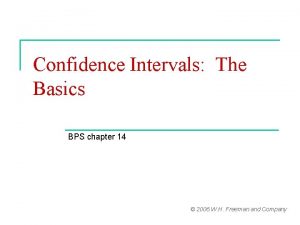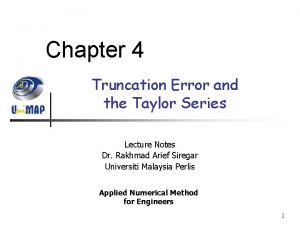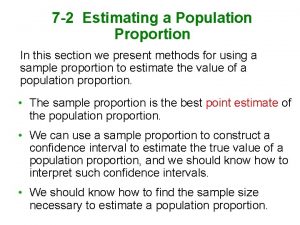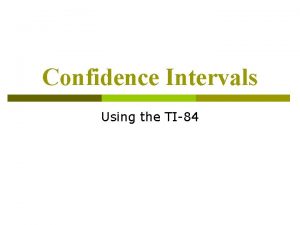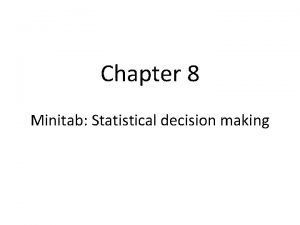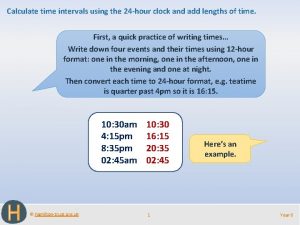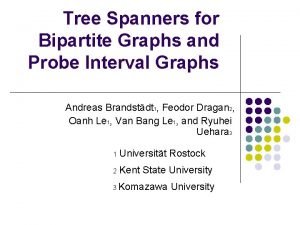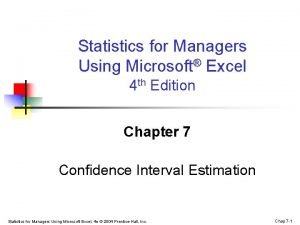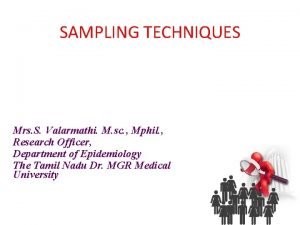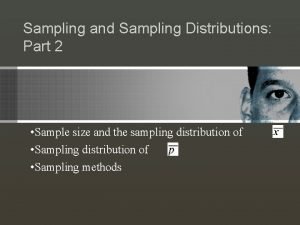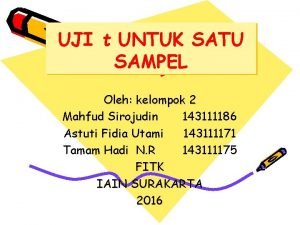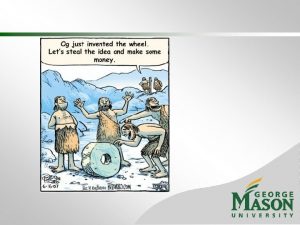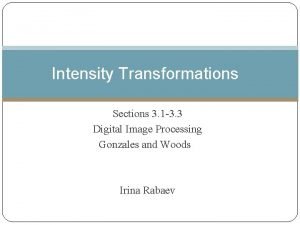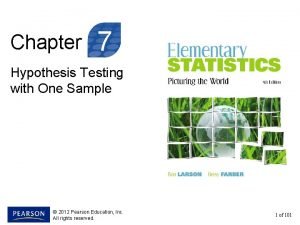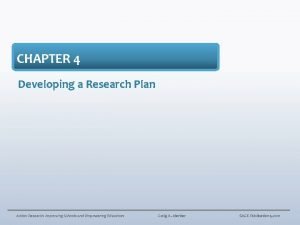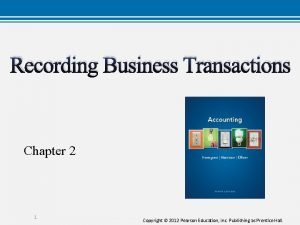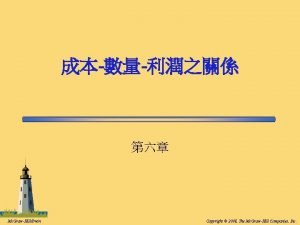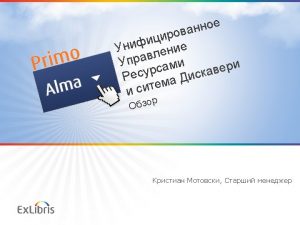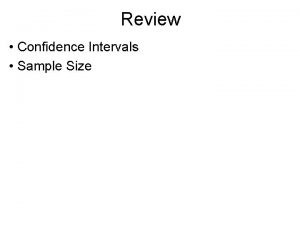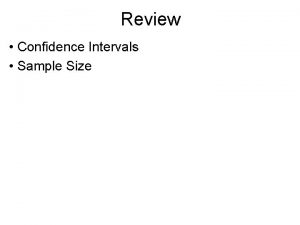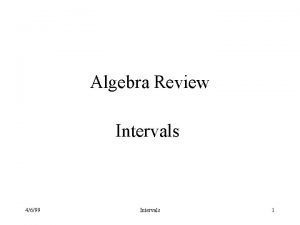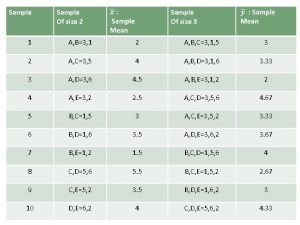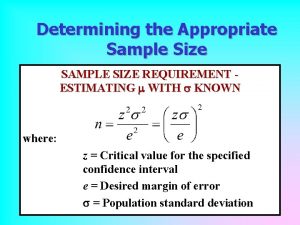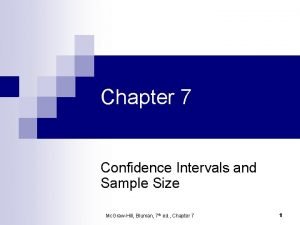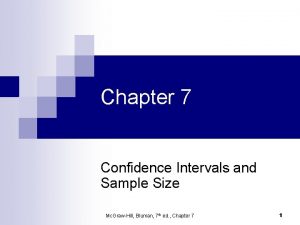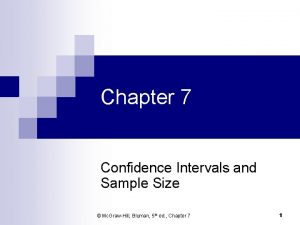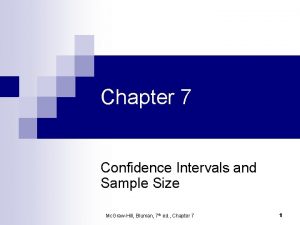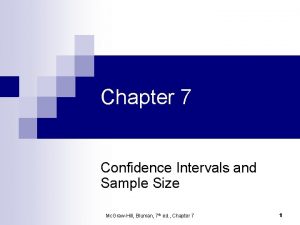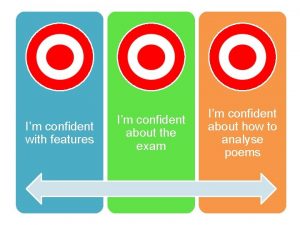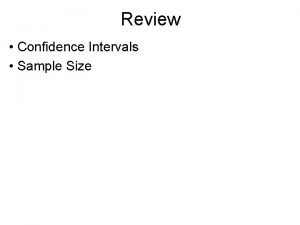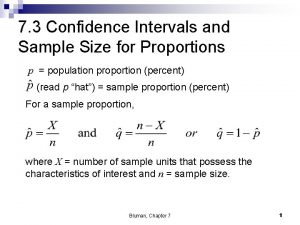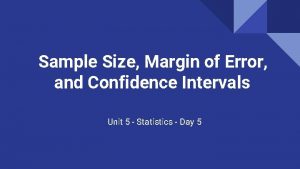Chapter 7 Confident Intervals and Sample Size Copyright




























































































































- Slides: 124

Chapter 7 Confident Intervals and Sample Size Copyright © 2013 The Mc. Graw-Hill Companies, Inc. Permission required for reproduction or display. 1

Confidence Intervals and Sample Size Outline 7 7 -1 Confidence Intervals for the Mean When Is Known 7 -2 Confidence Intervals for the Mean When Is Unknown 7 -3 Confidence Intervals and Sample Size for Proportions 7 -4 Confidence Intervals for Variances and Standard Deviations

Confidence Intervals and Sample Size Objectives 1 2 3 4 5 7 Find the confidence interval for the mean when is known. Determine the minimum sample size for finding a confidence interval for the mean. Find the confidence interval for the mean when is unknown. Find the confidence interval for a proportion. Determine the minimum sample size for finding a confidence interval for a proportion.

Confidence Intervals and Sample Size Objectives 6 7 Find a confidence interval for a variance and a standard deviation.

7. 1 Confidence Intervals for the Mean When Is Known • A point estimate is a specific numerical value estimate of a parameter. • The best point estimate of the population mean µ is the sample mean Bluman, Chapter 7 5

Three Properties of a Good Estimator 1. The estimator should be an unbiased estimator That is, the expected value or the mean of the estimates obtained from samples of a given size is equal to the parameter being estimated. Bluman, Chapter 7 6

Three Properties of a Good Estimator 2. The estimator should be consistent. For a consistent estimator, estimator as sample size increases, the value of the estimator approaches the value of the parameter estimated. Bluman, Chapter 7 7

Three Properties of a Good Estimator 3. The estimator should be a relatively efficient estimator; estimator that is, of all the statistics that can be used to estimate a parameter, the relatively efficient estimator has the smallest variance. Bluman, Chapter 7 8

Confidence Intervals for the Mean When Is Known • An interval estimate of a parameter is an interval or a range of values used to estimate the parameter. • This estimate may or may not contain the value of the parameter being estimated. Bluman, Chapter 7 9

Confidence Level of an Interval Estimate • The confidence level of an interval estimate of a parameter is the probability that the interval estimate will contain the parameter, assuming that a large number of samples are selected and that the estimation process on the same parameter is repeated. Bluman, Chapter 7 10

Confidence Interval • A confidence interval is a specific interval estimate of a parameter determined by using data obtained from a sample and by using the specific confidence level of the estimate. Bluman, Chapter 7 11

Confidence Intervals for the Mean (σ Known or n ≥ 30) and Sample Size

Formula for the Confidence Interval of the Mean for a Specific a For a 90% confidence interval: For a 95% confidence interval: For a 99% confidence interval: Bluman, Chapter 7 13

95% Confidence Interval of the Mean Bluman, Chapter 7 14


Maximum Error of the Estimate The maximum error of the estimate is the maximum likely difference between the point estimate of a parameter and the actual value of the parameter. Bluman, Chapter 7 16

Confidence Interval for a Mean Rounding Rule When you are computing a confidence interval for a population mean by using raw data, round off to one more decimal place than the number of decimal places in the original data. When you are computing a confidence interval for a population mean by using a sample mean and a standard deviation, round off to the same number of decimal places as given for the mean. Bluman, Chapter 7 17

Chapter 7 Confidence Intervals and Sample Size Section 7 -1 Example 7 -1 Page #358 Bluman, Chapter 7 18

Example 7 -1: Days to Sell an Aveo A researcher wishes to estimate the number of days it takes an automobile dealer to sell a Chevrolet Aveo. A sample of 50 cars had a mean time on the dealer’s lot of 54 days. Assume the population standard deviation to be 6. 0 days. Find the best point estimate of the population mean and the 95% confidence interval of the population mean. The best point estimate of the mean is 54 days. Bluman, Chapter 7 19

Example 7 -1: Days to Sell an Aveo One can say with 95% confidence that the interval between 52 and 56 days contains the population mean, based on a sample of 50 automobiles. Bluman, Chapter 7 20

Chapter 7 Confidence Intervals and Sample Size Section 7 -1 Example 7 -2 Page #358 Bluman, Chapter 7 21

Example 7 -2: Waiting Times A survey of 30 emergency room patients found that the average waiting time for treatment was 174. 3 minutes. Assuming that the population standard deviation is 46. 5 minutes, find the best point estimate of the population mean and the 99% confidence of the population mean. Bluman, Chapter 7 22

Example 7 -2: Waiting Times Hence, one can be 99% confident that the mean waiting time for emergency room treatment is between 152. 4 and 196. 2 minutes. Bluman, Chapter 7 23

95% Confidence Interval of the Mean Bluman, Chapter 7 24

95% Confidence Interval of the Mean One can be 95% confident that an interval built around a specific sample mean would contain the population mean. Bluman, Chapter 7 25

Finding for 98% CL. Bluman, Chapter 7 26

A sample of the reading scores of 35 fifthgraders has a mean of 82. The standard deviation of 95% the sample is 15. a. Find the confidence interval of the mean reading scores of all fifthgraders. b. Find the 99% confidence interval of the mean reading scores of all fifthgraders. c. Which interval is larger? Explain why.





The 99% confidence interval is larger because the confidence level is larger.

A study of 40 English composition professors showed that they spent, on average, 12. 6 minutes correcting a student’s term paper. a. Find the 90% confidence interval of the mean time for all composition papers when = 2. 5 minutes. b. If a professor stated that he spent, on average, 30 minutes correcting a term paper, what would be your reaction?

a. Find the 90% confidence interval of the mean time for all composition papers when = 2. 5 minutes.

b. If a professor stated that he spent, on average, 30 minutes correcting a term paper, what would be your reaction? It would be highly unlikely since this is far larger than 13. 3 minutes.

47 95 54 33 64 4 8 57 9 80 8 90 3 49 4 44 79 80 48 16 68 7 15 21 52 6 78 109 40 50 29 A random sample of the number of farms (in thousands) in various states is found above. Estimate the mean number of farms per state with 90% confidence.

47 95 54 33 64 4 8 57 9 80 8 90 3 49 4 44 79 80 48 16 68 7 15 21 52 6 78 109 40 50 29 or

Chapter 7 Confidence Intervals and Sample Size Section 7 -1 Example 7 -3 Page #360 Bluman, Chapter 7 38

Example 7 -3: Credit Union Assets The following data represent a sample of the assets (in millions of dollars) of 30 credit unions in southwestern Pennsylvania. Find the 90% confidence interval of the mean. 12. 23 16. 56 4. 39 2. 89 1. 24 2. 17 13. 19 9. 16 1. 42 73. 25 1. 91 14. 64 11. 59 6. 69 1. 06 8. 74 3. 17 18. 13 7. 92 4. 78 16. 85 Bluman, Chapter 7 39

Example 7 -3: Credit Union Assets Step 1: Find the mean and standard deviation. Using technology, we find = 11. 091 and s = 14. 405. Assume 14. 405. Step 2: Find α/2. 90% CL α/2 = 0. 05. Step 3: Find zα/2. 90% CL α/2 = 0. 05 z. 05 = 1. 65 Table E The Standard Normal Distribution z . 00 … . 04 . 05 0. 9495 0. 9505 … . 09 0. 0 0. 1. 6 Bluman, Chapter 7 40

Example 7 -3: Credit Union Assets Step 4: Substitute in the formula. One can be 90% confident that the population mean of the assets of all credit unions is between $6. 752 million and $15. 430 million, based on a sample of 30 credit unions. Bluman, Chapter 7 41

Technology Note This chapter and subsequent chapters include examples using raw data. If you are using computer or calculator programs to find the solutions, the answers you get may vary somewhat from the ones given in the textbook. This is so because computers and calculators do not round the answers in the intermediate steps and can use 12 or more decimal places for computation. Also, they use more exact values than those given in the tables in the back of this book. These discrepancies are part and parcel of statistics. Bluman, Chapter 7 42

Formula for Minimum Sample Size Needed for an Interval Estimate of the Population Mean where E is the margin of error. If necessary, round the answer up to obtain a whole number. That is, if there is any fraction or decimal portion in the answer, use the next whole number for sample size n. Bluman, Chapter 7 43

Chapter 7 Confidence Intervals and Sample Size Section 7 -1 Example 7 -4 Page #362 Bluman, Chapter 7 44

Example 7 -4: Depth of a River A scientist wishes to estimate the average depth of a river. He wants to be 99% confident that the estimate is accurate within 2 feet. From a previous study, the standard deviation of the depths measured was 4. 33 feet. How large a sample is required? Therefore, to be 99% confident that the estimate is within 2 feet of the true mean depth, the scientist needs at least a sample of 32 measurements. Bluman, Chapter 7 45

s = 2. 5 confidence level = 95% maximum error = 1 day

s = 2. 5 confidence level = 95% maximum error = 1 day or n = 24. 01

7. 2 Confidence Intervals for the Mean When Is Unknown The value of , when it is not known, must be estimated by using s, the standard deviation of the sample. When s is used, especially when the sample size is small (less than 30), critical values greater than the values for are used in confidence intervals in order to keep the interval at a given level, such as the 95%. These values are taken from the Student t distribution, distribution most often called the t distribution Bluman, Chapter 7 48

Characteristics of the t Distribution The t distribution is similar to the standard normal distribution in these ways: 1. It is bell-shaped. 2. It is symmetric about the mean. 3. The mean, median, and mode are equal to 0 and are located at the center of the distribution. 4. The curve never touches the x axis. Bluman, Chapter 7 49

Characteristics of the t Distribution The t distribution differs from the standard normal distribution in the following ways: 1. The variance is greater than 1. 2. The t distribution is actually a family of curves based on the concept of degrees of freedom, which is related to sample size. 3. As the sample size increases, the t distribution approaches the standard normal distribution. Bluman, Chapter 7 50

Degrees of Freedom • The symbol d. f. will be used for degrees of freedom • The degrees of freedom for a confidence interval for the mean are found by subtracting 1 from the sample size. That is, d. f. = n – 1. • Note: For some statistical tests used later in this book, the degrees of freedom are not equal to n – 1. Bluman, Chapter 7 51

Formula for a Specific Confidence Interval for the Mean When Is Unknown and n < 30 The degrees of freedom are n – 1. Bluman, Chapter 7 52

Chapter 7 Confidence Intervals and Sample Size Section 7 -2 Example 7 -5 Page #369 Bluman, Chapter 7 53

Example 7 -5: Using Table F Find the tα/2 value for a 95% confidence interval when the sample size is 22. Degrees of freedom are d. f. = 21. Bluman, Chapter 7 54


Chapter 7 Confidence Intervals and Sample Size Section 7 -2 Example 7 -6 Page #370 Bluman, Chapter 7 56

Example 7 -6: Sleeping Time Ten randomly selected people were asked how long they slept at night. The mean time was 7. 1 hours, and the standard deviation was 0. 78 hour. Find the 95% confidence interval of the mean time. Assume the variable is normally distributed. Since is unknown and s must replace it, the t distribution (Table F) must be used for the confidence interval. Hence, with 9 degrees of freedom, tα/2 = 2. 262. Bluman, Chapter 7 57

Example 7 -6: Sleeping Time One can be 95% confident that the population mean is between 6. 5 and 7. 7 hours. Bluman, Chapter 7 58

Chapter 7 Confidence Intervals and Sample Size Section 7 -2 Example 7 -7 Page #370 Bluman, Chapter 7 59

Example 7 -7: Home Fires by Candles The data represent a sample of the number of home fires started by candles for the past several years. Find the 99% confidence interval for the mean number of home fires started by candles each year. 5460 5900 6090 6310 7160 8440 9930 Step 1: Find the mean and standard deviation. The mean is = 7041. 4 and standard deviation s = 1610. 3. Step 2: Find tα/2 in Table F. The confidence level is 99%, and the degrees of freedom d. f. = 6 t. 005 = 3. 707. Bluman, Chapter 7 60

Example 7 -7: Home Fires by Candles Step 3: Substitute in the formula. One can be 99% confident that the population mean number of home fires started by candles each year is between 4785. 2 and 9297. 6, based on a sample of home fires occurring a period of 7 years. Bluman, Chapter over 7 61


5 31 18 58 33 16 29 132 35 45 15 37 19 39 24 13 18

A recent study of 28 employees of XYZ Company showed that the mean of the distance they traveled to work was 14. 3 miles. The standard deviation of the sample mean was 2 miles. Find the 95% confidence interval of the true mean.


If a manager wanted to be sure that most of his employees would not be late, how much time would he suggest they allow for the commute if the average speed is 30 miles per hour? about 30 minutes

Chapter 7 Confidence Intervals and Sample Size Section 7 -3 Exercise #19

The average yearly income for 28 community college instructors was $56, 718. The standard deviation was $650. Find the 95% true mean. interval of the confidence


If a faculty member wishes to see if he or she is being paid below average, what salary value should he or she use? Use the lower bound of the confidence interval: $56, 466

7. 3 Confidence Intervals and Sample Size for Proportions p = population proportion (read p “hat”) = sample proportion For a sample proportion, where X = number of sample units that possess the characteristics of interest and n = sample size. Bluman, Chapter 7 71

Chapter 7 Confidence Intervals and Sample Size Section 7 -3 Example 7 -8 Page #376 Bluman, Chapter 7 72

Example 7 -8: Air Conditioned Households In a recent survey of 150 households, 54 had central air conditioning. Find and , where is the proportion of households that have central air conditioning. Since X = 54 and n = 150, Bluman, Chapter 7 73

Formula for a Specific Confidence Interval for a Proportion when np 5 and nq 5. Rounding Rule: Round off to three decimal places. Bluman, Chapter 7 74

Chapter 7 Confidence Intervals and Sample Size Section 7 -3 Example 7 -9 Page #377 Bluman, Chapter 7 75

Example 7 -9: Covering College Costs A survey conducted by Sallie Mae and Gallup of 1404 respondents found that 323 students paid for their education by student loans. Find the 90% confidence of the true proportion of students who paid for their education by student loans. Bluman, Chapter 7 76

Example 7 -9: Covering College Costs Since α = 1 – 0. 90 = 0. 10, zα/2 = 1. 65. Bluman, Chapter 7 77

Example 7 -9: Covering College Costs You can be 90% confident that the percentage of students who pay for their college education by student loans is between 21. 1 and 24. 9%. Bluman, Chapter 7 78

Chapter 7 Confidence Intervals and Sample Size Section 7 -3 Example 7 -10 Page #377 Bluman, Chapter 7 79

Example 7 -10: Religious Books A survey of 1721 people found that 15. 9% of individuals purchase religious books at a Christian bookstore. Find the 95% confidence interval of the true proportion of people who purchase their religious books at a Christian bookstore. You can say with 95% confidence that the true percentage is between 14. 2% and 17. 6%. Bluman, Chapter 7 80



11% is contained in the confidence interval.

A survey found that out of 200 workers, 168 said they were interrupted three or more times an hour by phone messages, faxes, etc. Find the 90% confidence interval of the population proportion of workers who are interrupted three or more times an hour.



Find the 99% confidence interval of the true proportion. n = 200


The University of Michigan study falls within this confidence interval.

Chapter 7 Confidence Intervals and Sample Size Section 7 -4 Exercise #15




Formula for Minimum Sample Size Needed for Interval Estimate of a Population Proportion If necessary, round up to the next whole number. Bluman, Chapter 7 94

Chapter 7 Confidence Intervals and Sample Size Section 7 -3 Example 7 -11 Page #378 Bluman, Chapter 7 95

Example 7 -11: Home Computers A researcher wishes to estimate, with 95% confidence, the proportion of people who own a home computer. A previous study shows that 40% of those interviewed had a computer at home. The researcher wishes to be accurate within 2% of the true proportion. Find the minimum sample size necessary. The researcher should interview a sample of at least 2305 people. Bluman, Chapter 7 96

Chapter 7 Confidence Intervals and Sample Size Section 7 -3 Example 7 -12 Page #378 Bluman, Chapter 7 97

Example 7 -12: M&M Colors A researcher wishes to estimate the percentage of M&M’s that are brown. He wants to be 95% confident and be accurate within 3% of the true proportion. How large a sample size would be necessary? Since no prior knowledge of is known, assign a value of 0. 5 and then = 1 – 0. 5 = 0. 5. Substitute in the formula, using E = 0. 03. Bluman, Chapter 7 98

Example 7 -12: M&M Colors Bluman, Chapter 7 99

7 -4 Confidence Intervals for Variances and Standard Deviations • When products that fit together (such as pipes) are manufactured, it is important to keep the variations of the diameters of the products as small as possible; otherwise, they will not fit together properly and will have to be scrapped. • In the manufacture of medicines, the variance and standard deviation of the medication in the pills play an important role in making sure patients receive the proper dosage. • For these reasons, confidence intervals for variances and standard deviations are necessary. Bluman, Chapter 7 100

Chi-Square Distributions • The chi-square distribution must be used to calculate confidence intervals for variances and standard deviations. • The chi-square variable is similar to the t variable in that its distribution is a family of curves based on the number of degrees of freedom. • The symbol for chi-square is (Greek letter chi, pronounced “ki”). • A chi-square variable cannot be negative, and the distributions are skewed to the right. Bluman, Chapter 7 101

Chi-Square Distributions n At about 100 degrees of freedom, the chi-square distribution becomes somewhat symmetric. n The area under each chi-square distribution is equal to 1. 00, or 100%. Bluman, Chapter 7 102

Formula for the Confidence Interval for a Variance Formula for the Confidence Interval for a Standard Deviation Bluman, Chapter 7 103

Chapter 7 Confidence Intervals and Sample Size Section 7 -4 Example 7 -13 Page #385 Bluman, Chapter 7 104

Example 7 -13: Using Table G Find the values for interval when n = 25. To find and for a 90% confidence , subtract 1 – 0. 90 = 0. 10. Divide by 2 to get 0. 05. To find , subtract 1 – 0. 05 to get 0. 95. Bluman, Chapter 7 105

Example 7 -13: Using Table G Use the 0. 95 and 0. 05 columns and the row corresponding to 24 d. f. in Table G. Bluman, Chapter 7 106

Confidence Interval for a Variance or Standard Deviation Rounding Rule When you are computing a confidence interval for a population variance or standard deviation by using raw data, round off to one more decimal places than the number of decimal places in the original data. When you are computing a confidence interval for a population variance or standard deviation by using a sample variance or standard deviation, round off to the same number of decimal places as given for the sample variance or standard deviation. Bluman, Chapter 7 107

Chapter 7 Confidence Intervals and Sample Size Section 7 -4 Example 7 -14 Page #387 Bluman, Chapter 7 108

Example 7 -14: Nicotine Content Find the 95% confidence interval for the variance and standard deviation of the nicotine content of cigarettes manufactured if a sample of 20 cigarettes has a standard deviation of 1. 6 milligrams. To find , subtract 1 – 0. 95 = 0. 05. Divide by 2 to get 0. 025. To find , subtract 1 – 0. 025 to get 0. 975. In Table G, the 0. 025 and 0. 975 columns with the d. f. 19 row yield values of 32. 852 and 8. 907, respectively. Bluman, Chapter 7 109

Example 7 -14: Nicotine Content You can be 95% confident that the true variance for the nicotine content is between 1. 5 and 5. 5 milligrams. You can be 95% confident that the true standard deviation is between 1. 2 and 2. 3 milligrams. Bluman, Chapter 7 110

Chapter 7 Confidence Intervals and Sample Size Section 7 -4 Example 7 -15 Page #387 Bluman, Chapter 7 111

Example 7 -15: Cost of Ski Lift Tickets Find the 90% confidence interval for the variance and standard deviation for the price in dollars of an adult singleday ski lift ticket. The data represent a selected sample of nationwide ski resorts. Assume the variable is normally distributed. 59 54 53 52 51 39 49 46 49 48 Using technology, we find the variance of the data is s 2 = 28. 2. In Table G, the 0. 05 and 0. 95 columns with the d. f. 9 row yield values of 16. 919 and 3. 325, respectively. Bluman, Chapter 7 112

Example 7 -15: Cost of Ski Lift Tickets You can be 95% confident that the true variance for the cost of ski lift tickets is between 15. 0 and 76. 3. You can be 95% confident that the true standard deviation is between $3. 87 and $8. 73. Bluman, Chapter 7 113

Find the 90% confidence interval for the variance and standard deviation for the time it takes a customer to place a telephone order with a large catalog company is a sample of 23 telephone orders has a standard deviation of 3. 8 minutes. Assume the variable is normally distributed.


Chapter 7 Confidence Intervals and Sample Size Section 7 -5 Exercise #6

Find the 99% confidence interval for the variance and standard deviation of the weights of 25 one-gallon containers of motor oil if a sample of 14 containers has a variance of 3. 2. Assume the variable is normally distributed.

Find the 99% confidence interval for the variance and standard deviation.

Chapter 7 Confidence Intervals and Sample Size Section 7 -5 Exercise #9

The number of calories in a 1 -ounce serving of various kinds of regular cheese is shown. Estimate the population variance and standard deviation with 90% confidence. 110 45 100 95 110 100 110 95 120 130 100 80 105 90 110 70 125 108


Chapter 7 Confidence Intervals and Sample Size Section 7 -5 Exercise #11

A service station advertises that customers will have to wait no more than 30 minutes for an oil change. A sample of 28 oil changes has a standard deviation of 5. 2 minutes. Find the 95% confidence interval of the population standard deviation of the time spent waiting for an oil change.

 Confident
Confident Statistical intervals for a single sample
Statistical intervals for a single sample Confident and assertive
Confident and assertive Fm 6-22 army
Fm 6-22 army Bryce often acts overly confident and daring
Bryce often acts overly confident and daring Chapter 20 more about tests and intervals
Chapter 20 more about tests and intervals Confident personality traits
Confident personality traits Word formation adventure
Word formation adventure Healthy confident individuals
Healthy confident individuals Means
Means Confident similes
Confident similes Standard deviation for two sample t test
Standard deviation for two sample t test 95 size means
95 size means Words that have the same denotation are called
Words that have the same denotation are called B confident
B confident Chapter 19 confidence intervals for proportions
Chapter 19 confidence intervals for proportions Chapter 18 confidence intervals for proportions
Chapter 18 confidence intervals for proportions Chapter 19: confidence intervals for proportions
Chapter 19: confidence intervals for proportions Power and sample size minitab
Power and sample size minitab How to find increasing and decreasing intervals on a graph
How to find increasing and decreasing intervals on a graph What is interval of increase
What is interval of increase Removable and nonremovable discontinuity
Removable and nonremovable discontinuity Histogram with unequal width
Histogram with unequal width Increasing and decreasing intervals
Increasing and decreasing intervals What are error intervals
What are error intervals Characteristics of a parabola
Characteristics of a parabola Class dd
Class dd Size separation in pharmaceutical engineering
Size separation in pharmaceutical engineering What is the sample size in qualitative research?
What is the sample size in qualitative research? Bandura ross and ross
Bandura ross and ross What is the sample size in qualitative research?
What is the sample size in qualitative research? Homogeneous sampling qualitative research
Homogeneous sampling qualitative research Factors affecting sample size
Factors affecting sample size How to calculate sample size in research
How to calculate sample size in research Sample size calculation example
Sample size calculation example Sample size formula
Sample size formula Double proportion formula
Double proportion formula Cochran's sample size formula
Cochran's sample size formula What is the sample size in qualitative research?
What is the sample size in qualitative research? Sample size equation
Sample size equation Yamane formula for sample size
Yamane formula for sample size C=0 sampling plan
C=0 sampling plan How to define sample size
How to define sample size Sudhakar patra
Sudhakar patra What is the critical value for 90 confidence interval
What is the critical value for 90 confidence interval Confidence interval formula sample mean
Confidence interval formula sample mean Features of quantitative research
Features of quantitative research Cohen's d effect size
Cohen's d effect size Vwo test duration calculator
Vwo test duration calculator Fiona alderdice
Fiona alderdice Sample ratio mismatch
Sample ratio mismatch Effect size for t-test
Effect size for t-test Blinded sample size re-estimation
Blinded sample size re-estimation Sample size
Sample size Conjoint analysis sample size rule of thumb
Conjoint analysis sample size rule of thumb Conjoint analysis sample size rule of thumb
Conjoint analysis sample size rule of thumb Presuril
Presuril Harvard sample size calculator
Harvard sample size calculator Power penelitian
Power penelitian Sample size
Sample size Initial sample size
Initial sample size Sample size symbol
Sample size symbol Sample size determination
Sample size determination Roscoe 1975 rule of thumb
Roscoe 1975 rule of thumb Sample size for multiple regression
Sample size for multiple regression Example of size of the business
Example of size of the business Mlpowsim
Mlpowsim Rare event
Rare event Astroglide india
Astroglide india Confidence level and significance level
Confidence level and significance level Mild left axis deviation
Mild left axis deviation How to do error intervals
How to do error intervals Error interval questions
Error interval questions What is the highest mark you can get on a foundation paper
What is the highest mark you can get on a foundation paper Normal ecg intervals
Normal ecg intervals Confidence interval vs confidence level
Confidence interval vs confidence level Reporting confidence intervals
Reporting confidence intervals Confidence intervals excel
Confidence intervals excel Truncation error intervals
Truncation error intervals Common critical values
Common critical values How to find confidence level on ti 84
How to find confidence level on ti 84 Confidence interval minitab
Confidence interval minitab How to write hour
How to write hour Monotone intervals
Monotone intervals Uged ilocano
Uged ilocano How to add 95 confidence intervals in excel
How to add 95 confidence intervals in excel Representative population
Representative population Volunteer sample vs convenience sample
Volunteer sample vs convenience sample Convenience sampling
Convenience sampling Cluster random sampling vs stratified
Cluster random sampling vs stratified Uji t satu sampel
Uji t satu sampel Clinical judgment measurement model
Clinical judgment measurement model Difference between copyright and patent
Difference between copyright and patent What is the copyright designs and patents act 1988
What is the copyright designs and patents act 1988 Copyright designs and patents act 1988
Copyright designs and patents act 1988 Fair use guidelines for teachers
Fair use guidelines for teachers I the lord of sea and sky copyright
I the lord of sea and sky copyright Separation technique for red and blue marbles
Separation technique for red and blue marbles Intensity transformation
Intensity transformation Chapter 7 business plan
Chapter 7 business plan Chapter 7 hypothesis testing with one sample answers
Chapter 7 hypothesis testing with one sample answers Action research vs case study
Action research vs case study Introduction of chapter 3
Introduction of chapter 3 Irig chapter 10
Irig chapter 10 Electronic copyright office login
Electronic copyright office login Tmg copyright
Tmg copyright Copyright houghton mifflin company
Copyright houghton mifflin company Hunger games copyright
Hunger games copyright Copyright is debit or credit in trial balance
Copyright is debit or credit in trial balance Copyright 2015 all rights reserved
Copyright 2015 all rights reserved Population growth factors
Population growth factors It fw
It fw Copyright 2008
Copyright 2008 Proper netiquette practices to avoid copyright issues
Proper netiquette practices to avoid copyright issues Copyright
Copyright Encyclopedia britannica copyright
Encyclopedia britannica copyright Copyright
Copyright Copyright
Copyright 1mbti
1mbti Copyright disclaimer statement
Copyright disclaimer statement Copyright quiz for students
Copyright quiz for students Copyright notice on powerpoint slides
Copyright notice on powerpoint slides Berne convention
Berne convention Copyright
Copyright Copyright chaos
Copyright chaos
